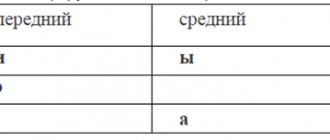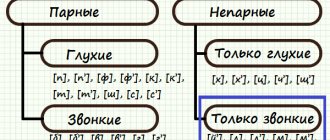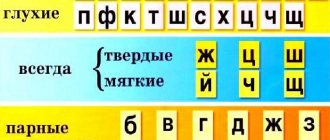Since vowel sounds vary articulatory and acoustically, sound classifications are based on these features. Each vowel sound has its own articulation, allowing it to be distinguished from other phonemes.
The articulatory classification of vowels is based on the fact that they are all characterized by three features:
- The degree of tongue elevation;
- The place where the tongue rises (row);
- Labialization - non-labialization.
Characteristics of vowels in the table
The phonetic transcription system uses all the vowels of the Russian alphabet, except for ya, yu, e, ё, which in Russian graphics denote the same sounds as a, u, e, o after soft consonants or a combination of sounds [ya], [yu] , [ye], [yo]. Thus, each vowel can be determined by a combination of three characteristics inherent in it. For example:
[e] - middle instep, front row, non-labialized, [y] - upper instep, back row, labialized, etc.
In the table, the composition of vowels of the Russian literary language with their characteristics can be presented in the following form:
| Climb | Row | ||
| front | average | rear | |
| Upper | And | s | at |
| Average | uh | O | |
| Lower | A | ||
| Non-labialized | Round | ||
The articulatory classification of vowels is studied in the section of the Russian language - phonetics. In order to pronounce words correctly, you need to know where vowel sounds are formed in the articulation apparatus.
Classification of vowel sounds.
Vowel sounds are speech sounds in the formation of which the outgoing stream of air does not encounter obstacles in the oral cavity, and therefore, acoustically, they are characterized by the predominance of a musical tone, or voice.
There are 6 vowel sounds in the Russian language: [a], [o], [e], [i], [s], [u]. They are most clearly heard under stress.
When pronouncing vowels, the shape and volume of the oral cavity may change. These changes depend on the participation or non-participation of the lips and the movement of the tongue vertically (the degree of elevation of the back of the tongue) and horizontally (the location of the elevation of the back of the tongue).
Based on the participation of the lips, all vowel sounds are divided into two groups: rounded vowels, or labialized (from the Latin labium - lip), - [o], [u] and unrounded, or non-labialized vowels, - [i], [e], [ ы], [а].
When producing the sounds [o], [u], the lips are rounded and pulled forward. The lips do not take an active part in the formation of the sounds [a], [e], [i], [s]. The sound [o] differs from [u] by a lesser degree of stretching and rounding of the lips. This can be easily noticed by muscle sensations when pronouncing, for example, the sounds [a] - [o] - [u] in a row.
According to the degree of rise of the back of the tongue, vowels of the upper, middle and lower rise are distinguished. When forming high vowels, which include the sounds [i], [s], [u], the tongue is raised to the greatest extent.
The formation of a lower vowel, which is the sound [a] in Russian, is characterized by a minimal rise of the tongue.
Mid-rise vowels, which include the sounds [e], [o], in terms of the degree of tongue elevation, occupy an intermediate position between high and low vowels.
It is easy to replace different degrees of tongue elevation by pronouncing, for example, the sounds [u] – [o] – [a] in a row.
According to the place where the back of the tongue rises, the vowels of the front, middle and back rows are distinguished.
When forming front vowels, which include the sounds [i], [e], the front part of the back of the tongue moves towards the hard palate.
The formation of back vowels - these are the sounds [u], [o] - occurs when the back of the back of the tongue moves towards the soft palate.
The middle vowels [ы], [а] at the point where the tongue rises occupy an intermediate position between the front and back vowels.
To make sure that when forming the front, middle and back vowels, the tongue articulates in different parts, you can pronounce in a row, for example, the sounds [i] - [s] - [u].
So, depending on the articulation in the Russian language, six different sounds are clearly perceived by ear: [i], [s], [u], [e], [o], [a].
Classification of consonant sounds.
Speech sounds consisting only of noise, or of voice and noise, which are formed in the oral cavity, where the stream of air exhaled from the lungs encounters various obstacles, are called consonants.
The consonant sounds of the Russian language contain 37 sound units, each of which in a certain position is capable of performing a semantic distinguishing function:
1) [b], [b'], [c], [c'], [d], [g'], [d], [d'], [h], [z'], [p] , [p'], [f], [f'], [k], [k'], [t], [t'], [s], [s'];
2) [l], [l'], [m], [m'], [n], [n'], [r], [r'];
3) [x], [x'], [g], [w], [c];
4) [h'], [j];
5) [w̅'], [zh̅'].
The classification of consonants is based on contrasting some features with others. In modern Russian, consonant sounds are divided according to several classification criteria (acoustic and articulatory):
1) by the participation of voice and noise;
2) by place of education;
3) by method of education;
4) by the presence or absence of palatalization (“softening”, from the Latin palatum - sky).
According to acoustic characteristics, consonants differ in the degree of participation of voice and noise. All consonants of the Russian language are divided into sonorant (from the Latin sonorus - sonorous) and noisy.
Sonorant sounds are characterized by the fact that in the composition of these sounds the voice predominates over noise. In modern Russian these include: [l], [l'], [m], [m'], [n], [n'], [r], [r'], [j].
Noisy consonants are characterized by the fact that their acoustic basis is noise, but there are noisy consonants that are formed not only with the help of noise, but with some participation of the voice. Among noisy ones there are noisy deaf and noisy voiced ones.
Noisy voiced sounds are formed by noise accompanied by voice. In modern Russian these include: [b], [b'], [v], [v'], [g], [g'], [d], [d'], [z], [z '], [zh], [zh̅'].
Noisy deafness is formed with the help of noise, without the participation of the voice. When pronouncing, their vocal cords are not tense or vibrate. In modern Russian these include: [k], [k'], [p], [p'], [s], [s'], [t], [t'], [f], [f '], [x], [x], [ts], [h'], [w], [w̅'].
Most noisy consonants of the Russian language are contrasted by deafness - voicedness: [b] - [p], [b'] - [p'], [v] - [f], [v'] - [f'], [d] – [t], [d'] – [t’], [z] – [s], [z’] – [s’], [g] – [w], [g] – [k], [ g'] – [k']; The voiceless consonants [ш̅'], [ц], [х], [х'], [ч'] do not have paired voiced consonants.
According to articulatory characteristics, the initial ones are the method of formation and the place of formation.
1. According to the place of noise formation , according to which speech organs take part in pronunciation, sounds are divided into labial and lingual.
a ) Labial consonants , in which the barrier is formed with the help of the lips or lower lip and upper teeth. In Russian, labials are divided into labiolabials ([b], [p], [m], [b'], [p'], [m']) and labiodentals ([v], [v'] , [f], [f']).
When producing labial sounds, the active organ is the lower lip, and the passive organ is either the upper lip (labial sounds) or the upper teeth (labial sounds).
b) Depending on which part of the tongue creates an obstruction, lingual consonants are divided into front-lingual, middle-lingual and posterior-lingual.
In Russian, front-lingual sounds include [d], [t], [n], [z], [s], [l] and the corresponding soft sounds [d'], [t'], [n'], [ z'], [s'], [l'], as well as [ts], [h'], [sh], [sh̅'], [zh̅'].
The front-lingual ones include:
1) dental: [t], [t'], [d], [d'], [s], [s'], [z], [z'], [ts], [n], [n '], [l], [l'];
2 ) palatodental: [w], [sh̅'], [zh], [zh̅'], [p], [p'], [h'].
The division of anterior lingual sounds into dental and palatodental sounds is made taking into account the passive organ. In this case, either the upper teeth or the base of the upper teeth serve as such a passive organ.
Lingual sounds make up the majority of all consonant sounds: anterior lingual sounds are formed with the participation of the front part of the back of the tongue; midlingual - with the participation of the middle part of the back of the tongue; posterior lingual - with the participation of the back of the tongue.
Only [j] belongs to the middle language
Rear lingual sounds are [g], [k], [x], [g'], [k'], [x'].
2. According to the method of noise formation, consonants are divided into:
A) Explosive (closed), when pronounced, there is a complete closure of the speech organs, with the force overcome by an air stream. These are [b], [p], [d], [t], [g], [k] and the corresponding soft variants [b'], [p'], [d'], [t'], [ g'], [k'].
B) Frictional (fricatives), during the pronunciation of which the organs of speech do not close completely, resulting in the formation of a gap through which air passes. Friction consonants are otherwise called spirants (from the Latin spiro - I breathe). In Russian it is [v], [v'], [f], [f'], [z], [z'], [s], [s'], [zh], [zh̅'], [w], [w̅'], [x].
C) Affricates , when pronouncing these consonants, the speech organs close, forming a barrier, which is then torn apart by air, resulting in a gap. In this case, the closure and rupture are instantaneous. These are the sounds [ch'] and [ts]. When pronouncing the sounds [ch'] and [ts], it is necessary to strictly preserve two points of articulation: the stop and the gap. First, the tip of the tongue closes with the teeth (with the sound [ts]) or with the front part of the palate (with the sound [ch']), then the air with a slight explosion opens the organs of speech, which creates a gap through which the air noisily comes out, so the sound [ts] consists, as it were, of the sounds [t] and [s] fused together, and the sound [h'] - of the soft sounds [t'] and [sh̅'] fused together.
D) Trembling consonants , or vibrating, during the formation of which the active organs of speech vibrate. In Russian these are the sounds [р] and [р'].
D) Close-passive consonants, during the pronunciation of which the speech organs are completely closed, but are not interrupted by air, since the air passes through the nose or mouth. These sounds are [l], [l'], [m], [m'], [n], [n']. Thus, when the sounds [l] and [l'] are formed, the front part of the tongue closes with the upper teeth, but between the lateral edges of the tongue and the lateral teeth, gaps are formed through which air escapes. Therefore, the sounds [l] and [l'] are called lateral. When the sounds [m] and [m'] are formed, the lips close tightly, and when the sounds [n] and [n'] are formed, the tongue is tightly adjacent to the upper teeth; but no explosion occurs, since the air, without breaking the closed organs of speech, exits through the nose. Therefore, the sounds [m], [m'], [n], [n'] are called nasal.
3. Most consonant sounds of the Russian language are opposed to each other on the basis of hardness-softness: [b] - [b'], [p] - [p'], [v] - [v'], [f] - [f' ], [d] - [d'], [t] - [t'], [l] - [l'], [m] - [m'], [n] - [n'], [r] – [p'], [s] – [s’], [g] – [g’], [x] – [x’], [k] – [k’]: [nose] – [n’os ] – nose – carried; [vos] – [v'os] – cart – carried; [rat] – [r'at] – rad – row; [became] – [became'] – became – steel; [gave] - [gave'] - gave - distance; [brother] - [brother'] - brother - take.
When soft consonants are formed, an accompanying additional movement of the speech organs is added to the main sound-forming movement: the middle part of the back of the tongue rises up to the hard palate, as with the sound [j], as a result of which the consonant acquires a special sound, which we conventionally call softness. They have no pairs and are only hard: [zh], [w], [ts], only soft: [zh̅'], [w̅'], [h'], [j].
The concept of phoneme
The key concept of functional phonetics, or phonology, is the concept of phoneme. The term phoneme in linguistics refers to the shortest linear unit of the sound structure of a language.
From these shortest sound units, language units endowed with meaning are built. Consequently, although phonemes as such are not units of language, since in themselves they are devoid of meaning, the existence of language units - morphemes, words and their forms - is fundamentally impossible without the phonemes from which their signifiers are built.
On the relationship between phoneme and sound
Phonemes cannot be directly identified with sounds heard and pronounced by people in the process of speech communication. Phonemes are units of the sound structure of a language, while specific sounds heard and pronounced by people are phenomena of individual speech. At the same time, the reality directly given to a person in perception turns out to be sounds. And these sounds heard and pronounced by people in the process of speech communication represent a way of detecting and existing phonemes. Phonemes, as abstract units of the sound structure of language, do not have independent existence, but exist only in the sounds of speech.
How to make money if you know Russian
If you are ok with spelling and punctuation (or generally ok, despite minor shortcomings), you can make money on the Internet from texts.
At first, the income will be small - 40-60 rubles. per page, but gradually you will find your niche and earn at least 200-400 rubles. per page. This is really true, because I myself have walked this path, from text exchanges where they pay pennies to individual cooperation with webmasters.
If you don’t know where to start, come to the “Copywriting from Scratch” course, which we created with Vasily Blinov. We will tell you in simple words what copywriting is in principle, how to correctly write articles on the Internet, how to do optimization, and carry out semantic analysis of texts.
The course includes five practices - you will write articles for the websites vsvoemdome.ru and iklife.ru. We pay for each practice. Students who complete the course pay back half of its cost and have 5 texts in their portfolio published on thousands of blogs.
Sign up for the course “Copywriting from scratch”








